-

人教版新目标初中英语七年级下册Why do you like koalas教案2篇
单元整体说明(一)单元教材分析本单元的核心话题是描述动物和表达个人喜好,以及句式why do you like…? Because…。这也是本单元的教学重点。通过本单元的学习,学生应能较流利地运用所学词汇和句型描述动物,表达个人喜好。(二)单元知识结构1.词汇动物名称 tiger, elephant, koala, dolphin, etc.词汇描述性形容词: smart, cute, ugly, clever, shy, etc.国家名: Australia, South Africa2.句型Why do you like koala hears? Because they are cute.Where are pandas from? They're from China.What animals do you like? I like dolphins.(三)单元整体目标1.Master the vocabulary2.Master and use: Why do you like koalas? Because they am cute.Where are pandas from? They're from China.What animals do you like? I like dolphins.(四)单元教学重难点一览(五)单元学情分析学生此前已经学过由why, where, what 引导的特殊疑问句句型,具有了学习本单元知识的认知前提。形形色色的动物能激发学生的好奇心,产生了解它们的欲望,这有利于本单元知识的教学和学生学习兴趣的培养。
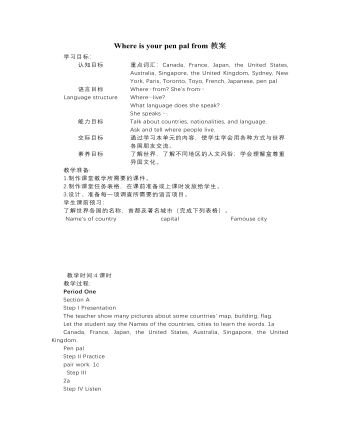
人教版新目标初中英语七年级下册Where is your pen pal from教案
2.1Match the country with the language.Step II Reading3a? let the students read the letter fast and answer the questions.? Let the students ask more questions about the letter as possible as the can.Step III Writing3b.Step IV. Pairwork2cStep V Listening2a, 2bStep V. HomeworkExercises book(1) P3Exercises book (2) P3Period FourStep I . Dictate the words and sentences in Unit1.Step II. Self-checkStep III. Check the answers for Exercises book in the unit.Step IV. Home workRevise and preparation for unit 2.教学反思:通过本单元的学习,学生基本可以谈论人们的国籍,居住城市及其所说的语言,通过书信方式去介绍自己并寻找笔友。但在涉及到国外的一些城市时,学生对这方面的知识相对欠缺,能介绍的城市并不多,也反应出学生课前预习不充分,这跟学生学习条件也有关,大多数学生无法通过网络获取所需信息。因此,在以后的教学中要多指导学生通过计算机网络获取信息,拓宽知识面。

人教版新目标初中英语七年级下册What do you think of game shows教案
五、教学Section B-2c1. Pair work: What do you think of the belt/sunglasses/…? What does your father/mother/… think of your scarf/belt…?2. Group work(1). Teacher shows some different kinds of school uniforms (制服)and asks : “ What do you think of your school uniforms? If you have a chance to choose your school uniforms, what kind would you like to choose?”(2). Discuss in groups.(3).Get some Ss to report in class.说明:这一步旨在让学生运用已有的语言知识谈论对事物的看法和意见,并简单阐明理由,培养学生的主动思维能力和运用英语的能力。六、教学拓展调查电视节目的收视率任务:调查你周围的人对现在各种电视节目的反响。活动过程:1.教师布置任务,让学生调查周围的人(包括他的亲戚朋友和邻居)喜欢收看哪方面的电视节目。2.学生进行调查活动,运用本单元所学的句型What do you think of….? (Why?)What's your favorite game shows?What do you think of talk show?I doesn’t mind it.I like it.I love it.I can’t stand it.3.记录下排在前10位的TV Program,填写调查表,比较其收视率。

人教版新目标初中英语七年级下册How was your weekend教案2篇
Teaching Goal:1. General aims:Talk about recent past events2. Particular aims:A. Language Focus.Talk about recent past events and think of the past events.B. Language goalsHow was….?It was …What did …do over the weekend?C. Language structures:(1). How was your weekend? I was great. Pay attention to no form.(2). What did you do over the weekend? I played soccer. We went to the beach.D. Useful words and phrases:Words: was, did, went, beach, over, project, test, wasn’t, false, number, geography, spend, week, most, mixture, their, had, little, cook, read, saw, change, everyone, sit, sat, no, anythingPhrases: did one’s homework, played soccer, cleaned my room, went to the beach, played tennis, went to the movies, on Saturday morning, over the weekend, cook … for, what about, do some reading, have a party, talk show, go shoppingE. Grammar language:Present simple past tenseRegular and irregular verbsF. Learning strategies:Tour and holidaysG. Interdiscipinary:H. Emotion and manner:Teaching time: 5 periodsTeaching procedures:Period One教学步骤、时间 教师活动 学生活动 媒体应用Step 1Free talk 3’ Ask some questions like:Who’s on duty today?What’s the weather like? Answer and talk about something.让同学们回答下列问题1. Do you like weekend? (Let some students answer)It takes them three minutes to talk about the question.2. Why do you like weekend? (let the students answer) Most of the students like the weekend此时教师用汉语问:“在周末期间问你干了什么?这句话用英语这么回答?Let the students guess.At last the teacher give them right answer3. What did you do over the weekend?(板书、学习)
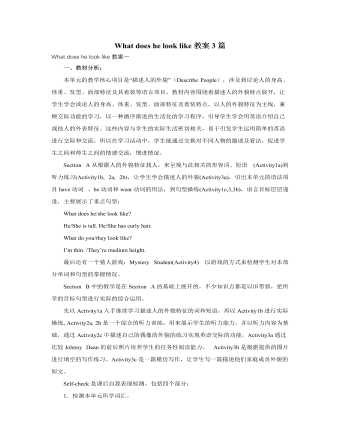
人教版新目标初中英语七年级下册What does he look like教案3篇
所需要用到的句子:Who is that?That is Jack. I like him.Why do you like him?I like him because he is interesting.Task 4: 设计理想中的人类Step one: 设计理想中的人类的外貌。把全班同学分成若干小组,学生可以边说边在纸上画出他们的模样。Step two: 设计理想中人类的性格。学生们可以把那些能描述性格的单词写在图画的旁边。Step three: 每组选出一名同学,其他同组同学提问,他作简单回答,并说明原因。所需用到的句子:What does he or she look like?He or she ...What is he or she like?He or she is ...Why?Because ...Task 5: 挑战性活动调查性格是天生的还是后天形成的,让每个同学回家去调查一下自己成长过程中性格是否有变化,具体是怎样的,为什么会这样? Teaching Aims:1. Enable students to have a general understanding of how to talk about people's physical appearance.2. Enable students to tackle some essential vocabularies and patterns about describing people. Provide them with necessary skills and methods.3. Create various chances for students to describe the persons they're familiar with, such as classmates, family members, teachers, idols, etc.

人教版新目标初中英语七年级下册Don’t eat in class教案2篇
Don’t fight. =You can’t fight. (板书,教读)教师把这些句子板书在黑板上,并请学生大声整齐地读祈使句和“can’t”句型,并让学生注意两种句型表达形式的不同和转换,“Don’t …=You can’t…”;并对学生说:These are our school rules. (板书,教读) You can’t break the school rules. Don’t break the school rules.(板书,教读)步骤3 :Practicea. T: Now, each of the students is breaking one of these rules.Please finish 1a.学生看图,完成1a的内容,检查答案并大声朗读校规。b. 听录音,完成1b,选出四位学生都违反了哪条校规;听之前,学生要读会英文名。c. 请两位学生朗读1c部分的句型;要求学生两人一组对话表演,SA扮演外校转来新生,SB告知本校校规。(学生可经过讨论,多说出他们想到的校规,不必只限于书上;教师应给予帮助)2) 第二课时(2a~4)步骤1 :warming up of revisionT: What are the rules at your school?学生使用“can”或祈使句表达各条校规;其中老师可引出“eat in the cafeteria outside”的表达。步骤2 :Practicea.T: Christina is an exchange student. She doesn’t know the rules. Let’s listen, what activities they’re talking about?学生听第一遍时,完成2a;第二遍时,完成2b;b. 请学生领读2c部分,看着2a完成的表格,理解2c活动的要求;分成小组针对2a进行问答;
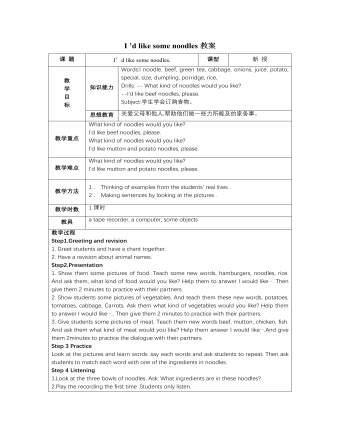
人教版新目标初中英语七年级下册I ’d like some noodles教案
教学过程Step 1: warming-up Sing a song---------“food and drink” Step 2: Revision1 Dictation2 Revise: What kind of noodles would you like?I’d like …What size bowl of noodles would you like?I’d like…Step 3: Presentation1 show pictures of food, ask students say the words.2 Students read the newspaper ad in 3a. Fill in blanks with words in the box. Then read the ad together, the teacher explains some difficult language points.3 Check the answers Step 4 PracticeAsk students to finish 3b in the same way according to 3a. Students read the short passage and fill in the blanks .At last, check the answers.Step 5 productionAsk students to write their own ad for dumplings, noodles, drinks, and other foods they know. Then ask students to read their partner’s ad. Then order food and drink from their partner.Step 6 Home workGroup work – make an ad about “food and drink”

人教版新目标初中英语七年级下册I want to be an actor教案2篇
三、教学建议第一课时:1. Lead in (Vocabulary)A) Before class, teacher should collect some pictures of working places. For example: Bank, TV Station, Restaurant, Police Station, Hospital ...B) In class, show students the pictures (PowerPoint, OHP). Ask students to tell the name of the working places and the name of the jobs.Shop assistant, doctor, actor, reporter, police office, waiter, bank clerk, studentC) Do exercise 1a and 3a.2. Bingo GameAsk groups of students to make up pairs of cards with a job on one and the related workplace on the other. For example, waiter / restaurant, teacher / school, doctor / hospital. Encourage students to use both the job / workplace combinations in the book and the ones that students came up during class discussions. Be sure they have twice as many sets of cards as there are students in the group. They can make two sets of cards for a single job / workplace, if necessary. Then have each group mix up its set of cards and hand their cards out in random order. Each time a student gets a pair of cards that match, he or she can lay these cards down. The goal is to have no cards in your hand at the end.3. Task OneA) Ask students to work in pairs and ask the partner what does he / she want to be in the future.e. g. :What do you / does he / does she want to be?I want to be a.Why?Because it's (adj).B) Vocabulary: Section B, 1a4. Homework 1.2.
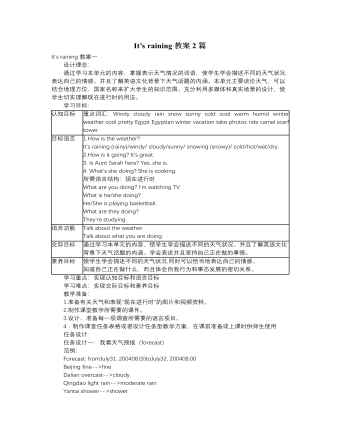
人教版新目标初中英语七年级下册It’s raining教案2篇
1 Each group choose one place to describe and what you are doing in it Choose one place, and describe what they are doing 2 Move around the room and give suggestions Talk about it and write it down 3 Ask one to show their works and act it Choose one of each group to make a report 4 Evaluate the best group and the best reporter Choose the best one Homework Ask your friends their ideal place and write about it教学反思:新课程标准中强调学生在课堂中的主体地位,在综合课中他们的主体地位就更加突出。在各个活动中给不同程度的学生不同层次的任务,让各层面的学生都有表现发挥的机会,从而产生对英语的兴趣。使用照片图片多媒体来辅助教学,效果更好。同时让了解其他国家风景,风俗的同学介绍ideal place,增加学生的背景知知识,实现跨学科交流的目的。教案点评:采用任务型教学模式,在各个活动中给不同程度的学生不同层次的任务,让各层面的学生都有表现发挥的机会,从而产生对英语的兴趣。使用照片图片多媒体来辅助教学,效果更好。让了解其他国家风景,风俗的同学介绍ideal place,增加学生的背景知识,实现跨学科交流的目的。

人教版新目标初中英语七年级下册Where did you go on vacation教案
句型: Where did you go on vacation? I went to summer camp.Did she go to Central Park?Yes,she did.No, she didn’t语法:一般过去时特殊疑问句、一般疑问句及肯、否定回答。课时安排4课时第一课时:Section A:la,1b,lc,2a,2b,2c 第二课时:Section A:3a,3b,4第三课时:Section B:1,2a,2b,2c第四课时:Section B:3a,3b,3c,4 and Self Check第一课时教学目标掌握描写假期生活的形容词。假期里自己所做事情的简单表达。谈论假期做的事情及当时情况。谈论假期时旅游的天气,旅游者以及食物等。教学过程一、导入播放一首英文歌曲:Let’s travel 说明:通过让学生听节奏欢快迪斯尼英语歌曲Let’s travel.引入本节课谈论的话题vacation and travel. 让歌曲使学生的思维活跃,增强课堂气氛,激发学生提高学习英语的兴趣。T:How is the trip ?Ss : It’s pretty good/ happy/exciting /relaxing/busy/dangerous/ fantastic说明:这个问题是为了操练形容词。建议让多个Ss作答。鼓励他们用不同的形容词。上述个别形容词本应在第二课时中出现,但可以在warming-up中第一次非正式出现。这些形容词也可在老师的评价语中适时出现,以加深学生对词汇的印象。
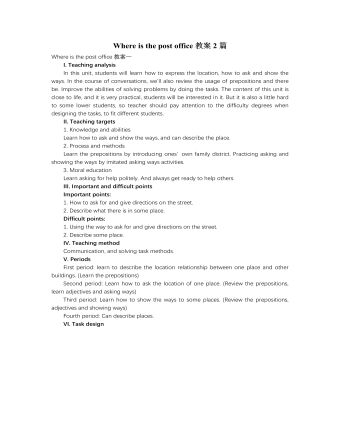
人教版新目标初中英语七年级下册Where is the post office教案2篇
Period 2 (3a----Section B 2c)Preview(Pre-task): Key points: What laAdd another information about their pen pals----their language on the cardnguage does she/he speak?She/He speaks....Does she/he have any brothers and sisters? Does she/he speak English?Preview(Pre-task): Add another information about their pen pals----their language on the cardKey points: What language does she/he speak?She/He speaks....Does she/he have any brothers and sisters? Does she/he speak English?Step 1 Revision1.Revisionand dictation of the new words 2.Revise the drills they learned yesterday.(by pairwork and grammar exercise)Step 2 Leading-inT has a conversation with one student. The conversation is following:---Do you have a pen pal?---Yes, I do.---What's your pen pal's name? ---His/Her name is....---Where is your pen pal from? ---He/She is from...---Where does he/she live? ---He/She lives in....---What language does he/she speak?He/She speaks...Write the new words on the Bb. They are following: EnglishChineseJapaneseFrenchStep 3 LearnLearn the new words with the whole class.Finish 3a with the students3b Pairwork T still does an example with one student Then the Ss practise in pairs. The example is following:--Curry Muray is my pen pal. He is from the United States.---What language does he speak?
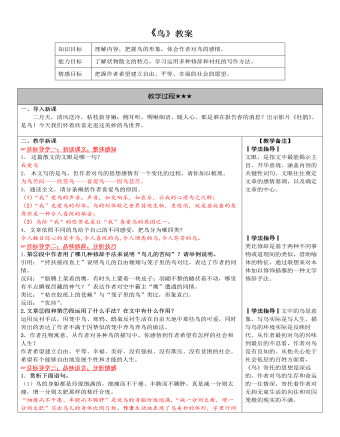
部编版语文七年级上册《鸟》教案
1.第②段中作者用了哪几种修辞手法来说明“鸟儿的苦闷”?请举例说明。引用:“抟扶摇而直上”说明鸟儿的自由翱翔与笼子里的鸟对比,表达了作者的同情。反问:“胳膊上架着的鹰,有时头上蒙着一块皮子;羽翮不整的蜷伏着不动,哪里有半点瞵视昂藏的神气?”表达作者对空中霸主“鹰”遭遇的同情。类比:“粘在胶纸上的苍蝇”与“笼子里的鸟”类比,形象直白。反语:“优待”。2.文章②段和第⑦段运用了什么手法?在文中有什么作用?运用反衬手法,用笼中鸟、寒鸦、鸱枭反衬生活在自由天地中那些鸟的可爱,同时突出的表达了作者不满于囚禁似的笼中养鸟养鸟的做法。3.作者托物寓意。从作者对各种鸟的描写中,你感悟到作者希望有怎样的社会和人生?作者希望建立自由、平等、幸福、美好、没有强权、没有欺压、没有贫困的社会。希望有个能够自由地发展个性和才能的人生。
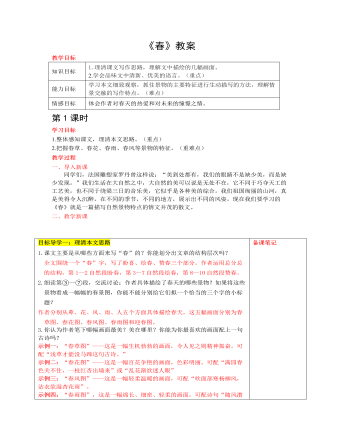
部编版语文七年级上册《春》教案
目标导学一:理清本文思路1.课文主要是从哪些方面来写“春”的?你能划分出文章的结构层次吗?全文围绕一个“春”字,写了盼喜、绘春、赞春三个部分。作者运用总分总的结构,第1—2自然段盼春,第3—7自然段绘春,第8—10自然段赞春。2.细读第③—⑦段,交流讨论:作者具体描绘了春天的哪些景物?如果将这些景物看成一幅幅的春景图,你能不能分别给它们拟一个恰当的三个字的小标题?作者分别从萆、花、风、雨、人五个方面具体描绘春天,这五幅画面分别为春草图、春花图、春风图、春雨图和迎春图。3.你认为作者笔下哪幅画面最美?美在哪里?你能为你最喜欢的画面配上一句古诗吗?示例一:“春草图”——这是一幅生机勃勃的画面,令人见之则精神振奋。可配“浅草才能没马蹄这句古诗。”
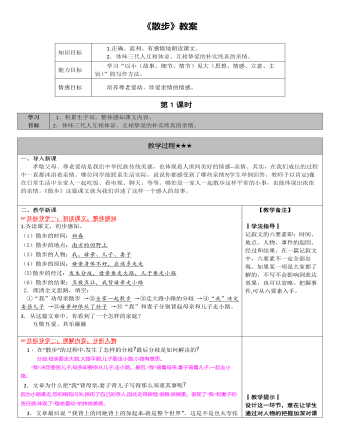
部编版语文七年级上册《散步》教案
二、教学新课?目标导学一:品读语言之美 请找出你认为最妙的一个词、最美的一句话,最精彩的一段文字,读一读,品一品。如生动的景物描写;贴切的修辞;特殊的句式;含义深刻的语句;精当的用词……1.写景的句子 (1)第四自然段“这南方初春的田野,大块小块的新绿随意地铺着,有的浓,有的淡;树上的嫩芽也密了;田里的冬水也咕咕地起着水泡。”分析:这段描绘了新绿、嫩芽、冬水,展现了春天的气息,生命的呼唤,写得富有诗意,读后使人似乎闻到了乡间田野泥土的芬芳,衬托了一家人散步时祥和、欢乐的情绪。 (2)第七自然段“她的眼随小路望去:那里有金色的菜花,两行整齐的桑树,尽头一口水波粼粼的鱼塘。”
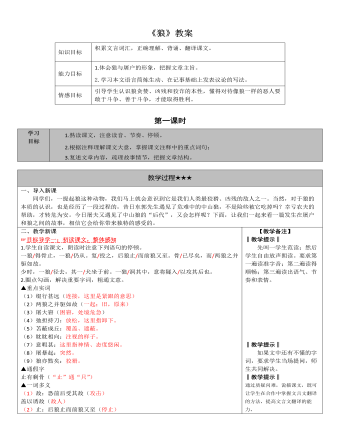
部编版语文七年级上册《狼》教案
二、教学新课?目标导学一:鉴赏描写,分析形象1.课文中哪些语句写出狼的贪婪凶恶、狡诈阴险的本性的?贪婪凶恶:缀行甚远;一狼得骨止一狼仍从;后狼止而前狼又至;而两狼之并驱如故。狡诈阴险:一狼径去,其一犬坐于前。目似瞑,意暇甚;意将遂入以攻其后也。2.文章是如何来刻画屠户的形象的?(要求从人物描写方法并以课文例句加以分析)(1)心理描写:惧——投骨避狼;大窘——骨尽狼仍从;恐——前后受其敌;悟——刀劈两狼。作者写出了屠户从妥协退让,到当机立断、奋起杀狼这一心理发展变化的过程。(2)动作描写:“投以骨”“复投之”写屠户试图投骨避狼,结果无效。“顾”“奔”“倚”“弛”“持”五个动词,写屠户迅速抢占有利的地形,保卫自己,准备反击。“暴起”“劈”“毙”写屠户趁一狼径去,一狼假寐的有利时机,当机立断,奋起杀狼,取得胜利。“转视”“断”“毙”等动词写屠户高度警惕,果断出击,再获全胜。
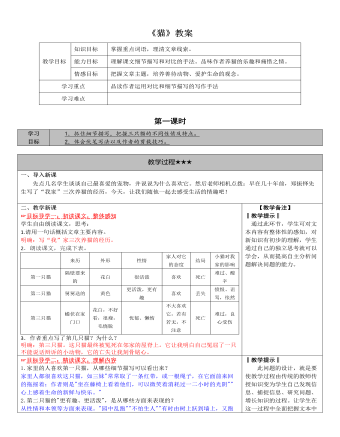
部编版语文七年级上册《猫》教案
目标导学二:精读课文,理解内容1.家里的人喜欢第一只猫,从哪些细节描写可以看出来?家里人都很喜欢这只猫,如三妹"常常取了一条红带,或一根绳子,在它面前来回的拖摇着;作者则是"坐在藤椅上看着他们,可以微笑着消耗过一二小时的光阴""心上感着生命的新鲜与快乐。"2.第二只猫的"更有趣、更活泼",是从哪些方面来表现的?从性情和本领等方面来表现。"园中乱跑""不怕生人""有时由树上跃到墙上,又跑到街上"等是表现它的性情;"会爬树""捉蝴蝶""会捉鼠"。3.第三只猫的“可厌”,是从哪些方面来描写的?是从形态和性情等方面来写的。“不好看,又很瘦”“毛被烧脱了好几块”“忧郁”“懒惰”。4.“我”根据什么判定芙蓉鸟是这只猫咬死的?是谁咬死了芙蓉鸟?根据是什么?“那只花白猫对于这一对黄鸟,似乎也特别注意,常常跳到桌子上对鸟笼凝望着。”是只凶恶的黑猫把鸟咬死。根据是:“一只黑猫飞快的逃过露台,嘴里衔着一只黄鸟”。5.为什么“我”对于第三只猫的死亡比前两只猫的亡失更“难过得多”?
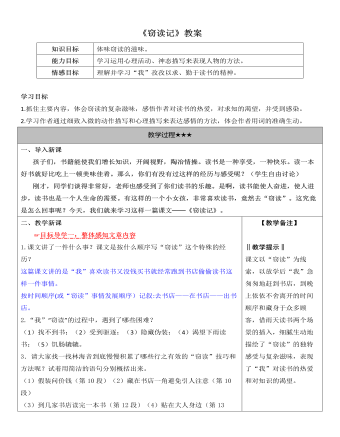
部编版语文七年级上册《窃读记》教案
(2)有时我贴在一个大人的身边,仿佛我是与他同来的小妹妹或者女儿。“贴”字形象地描绘出“我”躲在大人身边窃读的情形,出神入化地反映了“我”害怕被哄赶,又不愿意离开书店的心情。(3)我慌忙把眼睛送上书架,装作没看见。“送上”一词形象地描绘出“我”躲避店员时的慌乱与惧怕。3.理解下面句子的含义(1)记住,你是吃饭长大的;读书长大;也是在爱里长大的。吃饭长大,是人的生存需要;读书长大,是“我”在窃读过程中,不断获得知识,“我”的精神世界变得丰富、精彩;而后一次“窃读”,店员明知“我”不会买书,却依然留书给“我”“借读”。让我领悟了“爱”的真谛,也最终懂得了“我是在爱里长大的”。(2)我很快乐,也很惧怕---这种窃读的滋味!“我”在阅读中感受着书籍所带来的智慧与快乐,却时刻害怕被店员或老板发现受到训斥和哄赶,这种书内世界的吸引与沉迷,书外世界的担忧与紧张,使快乐与惧怕紧密地交织在一起,形成一种复杂的、难以言说的感受,正是窃读的滋味。

人教版新课标小学数学二年级下册总复习教案
教学时间:教学准备:小黑板,挂图。教学过程:一、复习旧知,引入新课。1、请大家想一想到今天为止,我们已经复习了本学期学过的哪些知识?(表内除法。万以内数的认识和加法、减法。克和千克及图形的变换。)2、对这些知识还有没有什么问题?还有没有内容是我们没有复习到或复习了掌握不好的?如果学生有问题,则针对问题,让同学们一起来想办法解决这些问题。学生提出问题,思考解决方法。二、复习整理:1、分别出示教材第122页第13、14题的挂图。(如果没有,就让学生直接看书)(1)看了图后,你明白图中的画是什么意思吗?学生看挂图,小组讨论这两题的意思。叙述两幅图的意思,没有说好的请其他同学来补充完整。在小组内讨论交流。(2)怎样来解决这两个生活中的实际问题?

人教版新课标小学数学五年级下册总复习教案
此图是一个复式折线统计图,考察内容是根据统计图,进行数据的有效分析。(1)因为统计图中蓝色的折线表示学龄儿童,根据对学龄儿童的折线数据分析发现:1980年的学龄儿童最多,2000年的学龄儿童最少。(2)根据题目要求的分析:没上学的学龄儿童实际上是指:学龄儿童的人数与实际入学儿童人数的差。通过仔细观察统计图,可以直观地发现:1980年的学龄儿童和入学人数之间的差值最大,2000年的学龄儿童和入学人数之间的差值最小。所以,1980年没上学的学龄儿童最多,2000年的最少。(3)这一问比较开放,只要合理即可。三、练习二十七第9——14题解答指导:9. 81cm3=81ml 700dm3=0.7m3 560ml=0.56L 2.3dm3=2300cm310. 根据图示可知:把铁皮做成一个长方体,长方体的长为30—5×2=20(cm),宽为25—5×2=15(cm),高也就是切去的正方形的边长5cm。(1)求“这个盒子用了多少铁皮?”也就是求这个铁皮盒子(无盖)的表面积。
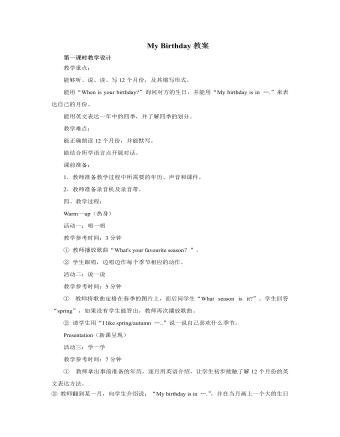
人教版新课标PEP小学英语五年级下册My Birthday教案
① 教师询问学生“What day is today?”,学生说出“Today is …”。而后又问学生:“What’s the date?”,帮助学生说出今天的具体日期:“It’s …”。 ② 让学生拿出课前准备的年历(最好是学生自己制作的),教师随意指着某天询问学生:“What’s the date?”,而后请学生拿着年历相互用“What’s the date? It’s ….”进行问答练习。③ 教师拿着年历从一月开始问学生:“Who has a birthday in January? Please stand up.”,而后教师问起立的学生:“What’s the date?”,让一月份生日的学生答出具体日期。④ 请若干名学生代替老师进行提问,从二月到十二月。活动四:Let’s talk教学参考时间:8分钟① 教师播放对话录音两遍,而后提问:“When is Sarah’s birthday? When is Zhang’s birthday?”,学生根据对话内容回答出:“Sarah’s birthday is in October1st. Zhang’s birthday’s is in March12th.”。 ② 学生跟读对话,两人一组做对话练习。 ③ 学生根据同学的生日组织一个新的对话,教师请若干组展示他们的对话。





















